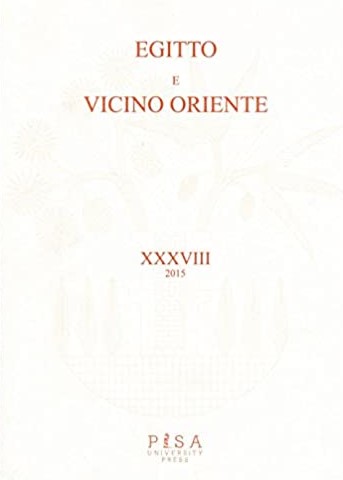
The Egyptian historian Manetho attributes the name “Misphragmuthosis” to the Pharaoh who defeated the Hyksos invaders. Around this name different interpretations have been formulated: from the most recent one of Ian Moyer to that proposed from Champollion and Rosellini after the Franco-Tuscan Expedition in Egypt, without excluding, however, a third hypothesis based on the “graecised” transliteration of King Ahmosis’s prename and name.
The present paper aims at analysing a topic so far unexplored, the three-dimensional representations of the bA-bird. By this definition I intend the well-known figurines and statuettes that almost every Egyptian museum and collection possesses. We know what these three-dimensional samples represent, nevertheless little is known of their origin and function due to the widespread lack of data about their original findspot. Starting from a description of the objects in question, I will deal with the first, hypothesized representations of the bA and the appearance of the human-headed bird iconography representing it, also proposing an interpretation for the first bA-bird statuettes. In the following step I will suggest why the bA-bird figurine production stepped up after the New Kingdom, taking into account the development that occurred within the funerary equipment. In doing so, I am aware that I am far from offering conclusive solutions but I hope that through this investigation this category of objects may receive further attention by scholars.
The object of this paper is the relief Florence 5412 (18th dynasty). It is often mentioned in the Egyptological literature, but it has never been specifically studied. The first part of this work is dedicated to determining its original provenience. Some scholars have argued that the fragment comes from el-Amarna or Saqqara. However the iconographic comparisons, the study of the decorative techniques of the tombs of the New Kingdom and the presence of the goddess Renenutet on the relief allowed to claim that its comes from Thebes.
In the second part of the paper is examined the place where Renenutet is depicted. Does it represent a chapel for the worship of the snake goddess? The identification of other similar scenes and the evidence provided by the inscriptions on some statues of the goddess, as well as some her epithets confirm the existence, near some storehouses and granaries, of places of worship dedicated to Renenutet, now irremediably lost and previously unknown
Concerning the black coffins with yellow decoration, which were in use from the reign of HatshepsutTuthmosis III to the reign of Ramses II, I have carried out an iconographic analysis on lid, case, inner surface, head end and foot end. As a result of this investigation, I have identified several iconographic characteristics that have allowed to me to put forward a more precise dating to the part of the coffins that had been generally dated between the 18th and 19th dynasty so far, and an original classification proposal.
The archaeological excavations carried out by the Istituto Papirologico “G. Vitelli” (University of Florence) between 2000 and 2013 in Antinoupolis (Egypt) brought to light different fragments of a particular type of glass bottle called Kuttrolf or guttrolf. The shape of this bottle with the body pinched four times in the middle to form vertical tubes joined to the centre by a thin membrane leaving a constricted central opening suggests that its purpose was to slow down the flow of its liquid content. The glass finds are dated by the context from the end of the 6th to the 7th centuries.
The present article focuses on a Christian Sasanian seal with Pahlavi inscription, preserved in the Bibliothèque Nationale of Paris, characterized by a figure of a naked standing man, holding a long cross in the left hand and a globe in the right one. This peculiar iconography seems to derive from a Roman prototype of “Jupiter Protector”, which was introduced in Roman coinage by Domitian, and that was later largely adopted by other emperors. Since some rare copper coins of Šābuhr II (309-79 CE) were over-struck on late Roman coins with the same iconography, it is likely that the Persians adopted this Western image by means of coins. Finally, the Christians of Persia, during the Fifth Century, transformed the sceptre of Jupiter into a cross, and put on the gem an augural legend, well-fitting with such “victorious” representation.
This paper follows the stages of the construction of legends about pre-Islamic Yemeni rulers’ gestae in Arab-Islamic historiography and literature, pointing out how narrative material of the Islamic conquests possibly contributed in this construction. The given examples concern specifically the story of Šammar Yurʿiš, the king of ancient Yemen well-known from epigraphic sources, and their presumptive raids and conquests in Central Asia, as exposed by South-Arabian historiographers from ʿAbīd b. Šariyya to Našwān al-Ḥimyarī.
Object of the paper is the lid of the coffin and the cartonnage of the musician of Amun Tentamonnesuttaui (Firenze, Museo Egizio, inv. no. 2176 and 2173). They were part of the intact assemblage of the woman, including her mummy, found during Ippolito Rosellini’s excavations at Thebes in an intact tomb – as he says –, and probably damaged during the sea travel from Alexandria to Italy. Both can be dated on the ground of internal iconographic and textual evidence to Dynasty 22. Her father, Hormes, was a priest and scribe of the army of the domain of Amun, probably an ancestor of Hormes, generalissimo of the army of the domain of Amun at the end of Dynasty 22, and owner of TT 126 at Sheikh Abd el-Gurna.
